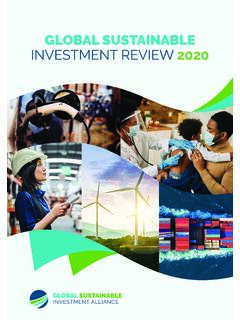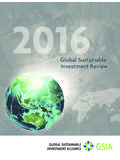Transcription of 2018 - GSIA
1 2018 global SUSTAINABLEINVESTMENT REVIEWTHANK YOU TO OUR SPONSORS WHO HELPED MAKE THIS REPORT POSSIBLE:1 2018 global sustainable investment REVIEWTABLE OF CONTENTSF oreword ..2 Executive Summary ..3 Introduction ..6 sustainable Investing Defined ..7 global sustainable Investments 2016 2018 ..8 Growth of global sustainable Investing Assets ..8 sustainable investment Strategies ..9 global Market Characteristics ..10 Regional Highlights ..13 Europe ..13 united states ..14 sustainable Investing in Latin America ..16 Canada ..17 Australia and New Zealand ..18 Investing for Impact in Africa ..19 Conclusion ..20 Appendix 1 Methodology and Data ..21 Appendix 2 Glossary.
2 24 Appendix 3 Data Table ..25 Acknowledgements ..262 2018 global sustainable investment REVIEWLisa Woll, CEO US SIF: The Forum for sustainable and Responsible investment and the US SIFF oundationFOREWORDThe global sustainable investment Alliance (GSIA) is an international collaboration of membership-based sustainable investment organizations. Our mission is to deepen and expand the practice of sustainable investment through intentional international collaboration. We are pleased to present the global sustainable investment Review 2018, the fourth edition in the series since our inaugural review of sustainable investment worldwide in 2012. Since 2016, when we released our last biennial review, sustainable and responsible investing has continued to grow in each of the five main regions discussed in this report: Australia and New Zealand, Canada, Europe, Japan and the united states , with particularly robust growth in Japan.
3 In each of these regions, sustainable investing commands a sizable share of total professionally managed assets. We are also pleased to provide snapshots on sustainable investing in Latin America and in Africa. We want to thank the many sponsors listed in the Acknowledgments page of the regional research reports used to prepare the global sustainable investment Review 2018. We also thank Hermes investment Management, RBC global Asset Management and UBS for the financial support they provided for the global review. Without the generous support of these sponsors, this report and the research on which it is based would not have been possible.
4 We are grateful to US SIF: The Forum for sustainable and Responsible investment , which led the production of the report, and particularly to US SIF Research Director Meg Voorhes. Sincerely, Masaru Arai, Chair Japan sustainable investment ForumDustyn Lanz, CEO Responsible investment Association CanadaSimon O Connor, CEO Responsible investment Association AustralasiaWill Oulton, Chair Eurosif, the European sustainable investment Forum3 2018 global sustainable investment REVIEWEXECUTIVE SUMMARYIn early 2017, the global sustainable investment Alliance (GSIA) released the global sustainable investment Review 2016, which collated the results from the market studies of regional sustainable investment forums for Europe, the united states , Canada, Japan, and Australia and New Zealand.
5 In the period since the last report was released , the global sustainable investment market has continued to grow, and in most of the regions covered by GSIA s member organizations, its share of professionally managed assets has also grown. This report summarizes the status of sustainable and responsible investing in these markets at the start of 2018. Generally in this report, when discussing the global tally of sustainable investing assets and how they break down by region or strategy, the assets are presented in US dollars. To show trends within each region over time, however, we present assets in the local currencies so as not to introduce exchange rate fluctuations.
6 sustainable investing is an investment approach that considers environmental, social and governance (ESG) factors in portfolio selection and management. For the purpose of this global report and for articulating our shared work in the broadest way, GSIA uses an inclusive definition of sustainable investing, without drawing distinctions between this and related terms such as responsible investing and socially responsible investing. This report primarily uses the term sustainable , sustainable investing assets in the five major markets stood at $ trillion at the start of 2018, a 34 percent increase in two years. In all the regions except Europe, sustainable investing s market share has also grown.
7 Responsible investment now commands a sizable share of professionally managed assets in each region, ranging from 18 percent in Japan to 63 percent in Australia and New Zealand. Clearly, sustainable investing constitutes a major force across global financial markets. From 2016 to 2018, the fastest growing region has been Japan, followed by Australia/New Zealand and Canada. These were also the three fastest growing regions in the previous two-year period. The largest three regions based on the value of their sustainable investing assets were Europe, the united states and Japan. sustainable investment encompasses the following activities and strategies: 1.
8 Negative/exclusionary screening, 2. Positive/best-in-class screening, 3. Norms-based screening, 4. ESG integration, 5. Sustainability themed investing, 6. Impact/community investing, and 7. Corporate engagement and shareholder action. As in 2016, the largest sustainable investment strategy globally is negative/exclusionary screening ($ trillion), followed by ESG integration ($ trillion) and corporate engagement/shareholder action ($ trillion). Negative screening remains the largest strategy in Europe, while ESG integration continues to dominate in the united states , Canada, Australia and New Zealand in asset-weighted terms. Corporate engagement and shareholder action is the dominant strategy in Japan.
9 4 2018 global sustainable investment REVIEWN orms-based screening has lost ground in Europe, with substantially fewer assets managed under this strategy than in 2016. Despite modest growth in Canada, and more rapid growth in Japan in assets managed under norms-based screening, the global total of these assets fell from 2016 to 2018. Impact investing is a small but vibrant segment of the broader sustainable and responsible investing universe in all the markets studied. GSIA defines impact investing as targeted investments aimed at solving social or environmental problems. Community investing, whereby capital is specifically directed to traditionally underserved individuals or communities, is included in this category, as is finance that is provided to businesses with an explicit social or environmental purpose.
10 In Europe, total assets committed to sustainable and responsible investment strategies grew by 11 percent from 2016 to 2018 to reach trillion ($ trillion), but their share of the overall market declined from 53 percent to 49 percent of total professionally managed assets. The slight drop may be due to a move to stricter standards and definitions. Although exclusionary screens remain the dominant strategy at trillion, this is down from the trillion reported under this strategy in 2016. Corporate engagement and shareholder action is now the second most widely practiced strategy, up from third place in 2016, with the assets involved in this strategy growing 14 percent.



